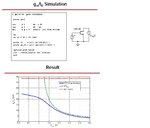aryajur
Advanced Member level 3
- Joined
- Oct 23, 2004
- Messages
- 793
- Helped
- 124
- Reputation
- 248
- Reaction score
- 37
- Trophy points
- 1,308
- Location
- San Jose, USA
- Activity points
- 7,788
The 1st graph, try sweeping the current to a larger value say 500uA or 1mA to see the full curve. I don't know what the size of the MOS is maybe you are not getting out of subthreshold with 1uA of current.
When they say gm/Id is region independent I think they only mean its independent of subthreshold-weak inversion-saturation. When the MOS goes into triode the the gm/Id curves I saw were not very consistent and varied all over the place as soon as I started nearing subthreshold.
What is Iref in the 1st graph? Is it the sweeping DC current source? If that is the case then when you plot gmoverid vs Id/(W/L) that should only change the scale of the x-axis and not the shape of the graph since W/L is constant throughout the sweep, right?
So it could be that something is going wrong in the Cadence plotting AWD. I myself could never get the plots to work in Cadence alone since it kept messing up when I changed the x-axis, I then simply ended up exporting the data to MATLAB/excel and did the plots much more easily.
When they say gm/Id is region independent I think they only mean its independent of subthreshold-weak inversion-saturation. When the MOS goes into triode the the gm/Id curves I saw were not very consistent and varied all over the place as soon as I started nearing subthreshold.
What is Iref in the 1st graph? Is it the sweeping DC current source? If that is the case then when you plot gmoverid vs Id/(W/L) that should only change the scale of the x-axis and not the shape of the graph since W/L is constant throughout the sweep, right?
So it could be that something is going wrong in the Cadence plotting AWD. I myself could never get the plots to work in Cadence alone since it kept messing up when I changed the x-axis, I then simply ended up exporting the data to MATLAB/excel and did the plots much more easily.
